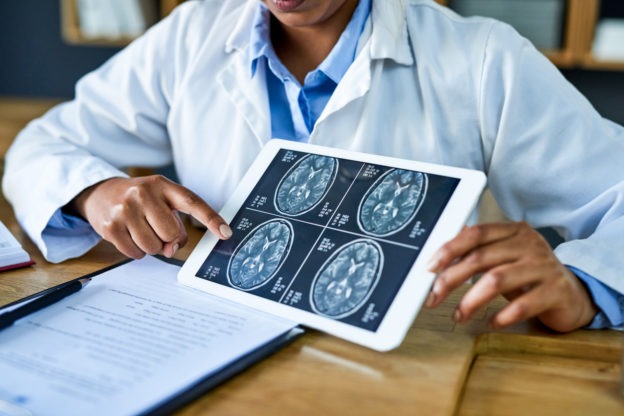Instructor
Nev Zubcevik, DO
Chief Medical Officer
Invisible International
Description
This course describes neuro-Lyme clinical presentations and discusses the foundational treatment strategies used to get patients back to living normal lives. Based on Dr. Zubcevik’s experience as a Harvard-trained, board-certified physical medicine and rehabilitation physician, she stresses the importance of a multidisciplinary “all hands on deck” approach for these patients, many of whom have serious deficits in memory and brain functioning. She recommends that coordination of care —appointment management, home support, physician referrals, and insurance coverage—be an integral part of any treatment plan. She says that mental health support and an anti-inflammatory diet are also key to a patient’s recovery. This is part 1 in a three course series on this topic.
Learning objectives
- Define Central Nervous System Lyme (CNS) Disease
- Describe ways to initialize differential diagnosis and diagnostic tools
- Identify three ways of approaching rehabilitation strategies for CNS Lyme
This session, Part 1 | Diagnostic, treatment & rehabilitation strategies for patients with CNS Lyme disease, is approved for 0.5 enduring AAFP Prescribed credits.
AAFP Prescribed credit is accepted by the American Medical Association as equivalent to AMA PRA Category 1 credit(s)™ toward the AMA Physician’s Recognition Award. When applying for the AMA PRA, Prescribed credit earned must be reported as Prescribed, not as Category 1.
The AAFP has reviewed One Health Medical Education for a Changing Climate and deemed it acceptable for AAFP credit. Term of approval is from 01/02/2024 to 01/01/2025. Physicians should claim only the credit commensurate with the extent of their participation in the activity.
References
Malawista SE, de Boisfleury Chevance A (2008) Clocking the Lyme Spirochete. PLOS ONE 3(2): e1633. https://doi.org/10.1371/journal.pone.0001633
Allen C. Steere, Gail McHugh, Nitin Damle, Vijay K. Sikand, Prospective Study of Serologic Tests for Lyme Disease, Clinical Infectious Diseases, Volume 47, Issue 2, 15 July 2008, Pages 188–195, https://doi.org/10.1086/589242
Stanek G, Reiter M. The expanding Lyme Borrelia complex–clinical significance of genomic species? Clin Microbiol Infect. 2011 Apr;17(4):487-93. doi: 10.1111/j.1469-0691.2011.03492.x. PMID: 21414082.
Miklossy, J., Kasas, S., Zurn, A.D. et al. Persisting atypical and cystic forms of Borrelia burgdorferiand local inflammation in Lyme neuroborreliosis. J Neuroinflammation 5, 40 (2008). https://doi.org/10.1186/1742-2094-5-40
Embers ME, Barthold SW, Borda JT, Bowers L, Doyle L, et al. (2012) Persistence of Borrelia burgdorferi in Rhesus Macaques following Antibiotic Treatment of Disseminated Infection. PLOS ONE 7(1): e29914. https://doi.org/10.1371/journal.pone.0029914
https://www.columbia-lyme.org/signs-and-symptoms
Parola P, Raoult D. Ticks and tickborne bacterial diseases in humans: an emerging infectious threat. Clin Infect Dis. 2001 Mar 15;32(6):897-928. doi: 10.1086/319347. Epub 2001 Mar 14. Erratum in: Clin Infect Dis 2001 Sep 1;33(5):749. PMID: 11247714.
Rupprecht TA, Koedel U, Fingerle V, Pfister HW. The pathogenesis of lyme neuroborreliosis: from infection to inflammation. Mol Med. 2008 Mar-Apr;14(3-4):205-12. doi: 10.2119/2007-00091.Rupprecht. PMID: 18097481; PMCID: PMC2148032.
Habicht GS, Katona LI, Benach JL. Cytokines and the pathogenesis of neuroborreliosis: Borrelia burgdorferi induces glioma cells to secrete interleukin-6. J Infect Dis. 1991 Sep;164(3):568-74. doi: 10.1093/infdis/164.3.568. PMID: 1908002.
Alaedini A, Latov N. Antibodies against OspA epitopes of Borrelia burgdorferi cross-react with neural tissue. J Neuroimmunol. 2005 Feb;159(1-2):192-5. doi: 10.1016/j.jneuroim.2004.10.014. Epub 2004 Nov 26. PMID: 15652419.
Schutzer SE, Coyle PK, Krupp LB, Deng Z, Belman AL, Dattwyler R, Luft BJ. Simultaneous expression of Borrelia OspA and OspC and IgM response in cerebrospinal fluid in early neurologic Lyme disease. J Clin Invest. 1997 Aug 15;100(4):763-7. doi: 10.1172/JCI119589. PMID: 9259573; PMCID: PMC508246.
http://www.ucmp.berkeley.edu/bacteria/spirochetes.html
http://www.sciencedirect.com/science/article/pii/S0165242798001354
Zubcevik N, Mao C, Wang QM, Bose EL, Octavien RN, Crandell D, Wood LJ. Symptom Clusters and Functional Impairment in Individuals Treated for Lyme Borreliosis. Front Med (Lausanne). 2020 Aug 21;7:464. doi: 10.3389/fmed.2020.00464. PMID: 32974369; PMCID: PMC7472530.15) Belman AL, Iyer M, Coyle PK, Dattwyler R. Neurologic manifestations in children with North American Lyme disease. Neurology. 1993 Dec;43(12):2609-14. doi: 10.1212/wnl.43.12.2609. PMID: 8255465.16)
Clin Nucl Med. 2012 Sep;37(9):e219-22. doi: 10.1097/RLU.0b013e318262ad9b. SPECT brain imaging in chronic Lyme disease.Donta ST, Noto RB, Vento JA.
Barthold S et al., 2010; AAC, 54:643-51; Hodzic E et al. 2014, PLoS One 9: e86907; Embers M et al. PLoS One 2012;7:e29914
Marques A et al. Clinical Infectious Diseases, 58:937-945, 2014
Qual Life Res. 2013 Feb;22(1):75-84.Post-treatment Lyme disease syndrome symptomatology and the impact on life functioning: is there something here?Aucott JN1, Rebman AW, Crowder LA, Kortte KB.
Clinical and electrophysiologic findings in chronic neuropathy of Lyme disease Eric L. Logigian, MD and Allen C. Steere. http:/ / dx. doi. org/ 10. 1212/ WNL. 42. 2. 303 Neurology February 1992 vol. 42 no. 2 303
Fallon BA, Zubcevik N, Bennett C, Doshi S, Rebman AW, Kishon R, Moeller JR, Octavien NR, Aucott JN. The General Symptom Questionnaire-30 (GSQ-30): A Brief Measure of Multi-System Symptom Burden in Lyme Disease. Front Med (Lausanne). 2019 Dec 6;6:283. doi: 10.3389/fmed.2019.00283. PMID: 31867334; PMCID: PMC6908481.
Nucl Med Commun. 2002 Aug;23(8):773-7.Cerebral metabolic changes associated with Lyme disease.Newberg A1, Hassan A, Alavi A.
Functional Brain Imaging and Neuropsychological Testing in Lyme Disease Brian A. Fallon et al. Clinical Infectious Diseases 1997;25(Suppl 1):S57–63 24)
J Infect Dis. 1999 Aug;180(2):377-83.Successful treatment of Lyme encephalopathy with intravenous ceftriaxone.Logigian EL1, Kaplan RF, Steere AC.25)
Am Orthopt J. 2006;56:147-50. doi: 10.3368/aoj.56.1.147.Lyme disease and convergence insufficiency: is it a near fit?Matta NS, Singman EL, McCarus C.
Med Sci Sports Exerc. 2015 Nov;47(11):2291-8. doi: 10.1249/MSS.0000000000000683.Supervised Resistance Exercise for Patients with Persistent Symptoms of Lyme Disease.D’Adamo CR1, McMillin CR, Chen KW, Lucas EK, Berman BM.
Suppression of Long-Lived Humoral Immunity Following Borrelia burgdorferi InfectionElsner et al Published: July 2, 2015 https://doi.org/10.1371/journal.ppat.1004976
J Neuroinflammation. 2011; 8: 90. doi: 10.1186/1742-2094-8-90PMCID: Alzheimer’s disease – a neurospirochetosis. Analysis of the evidence following Koch’s and Hill’s criteria


